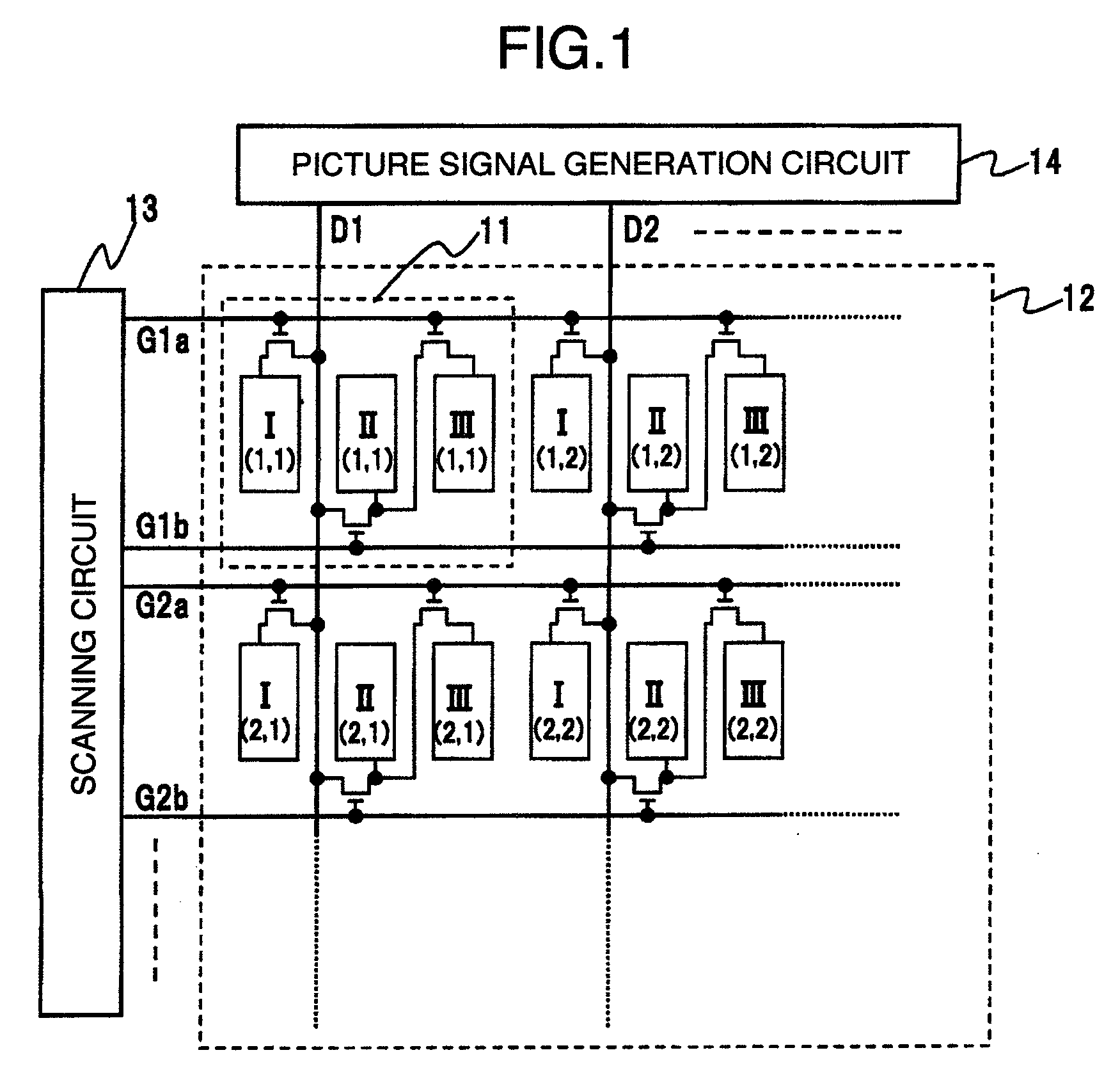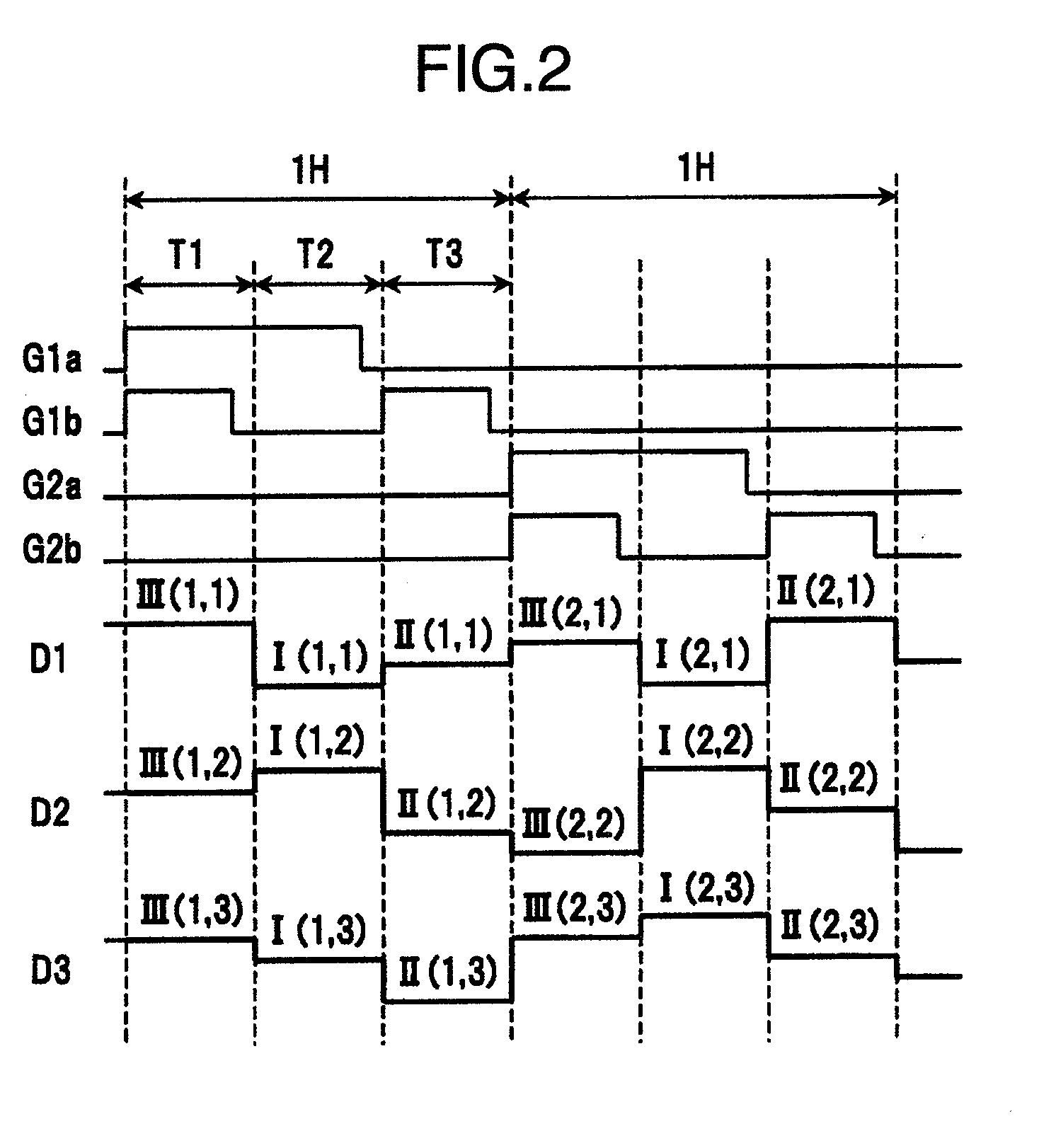Display device
a display panel and display technology, applied in the field of display devices, can solve the problems of increasing the number of gate lines, affecting the aperture, complicated circuit structure, etc., and achieve the effect of reducing the number of signal lines, and reducing the number of necessary wiring conductors for each pixel
- Summary
- Abstract
- Description
- Claims
- Application Information
AI Technical Summary
Benefits of technology
Problems solved by technology
Method used
Image
Examples
embodiment 1
[0035]FIG. 1 shows the layout of pixels in a display device as a first embodiment of this invention and FIG. 2 is a diagram showing the waveforms varying with time of signals for driving pixels shown in FIG. 1. As shown in FIGS. 1 and 2, according to this embodiment, signal voltages are distributed to three pixels by using two gate lines and one signal line.
[0036]In FIG. 1, gate lines are indicated by G1a, G1b, G2a, G2b, . . . , etc. while signal lines crossing these gate lines are denoted by D1, D2, . . . , etc. Transparent pixel electrodes I, II and III are disposed in the area of intersection between a gate line G and a signal line D. These transparent pixel electrodes I, II and III constitute a pixel 11 as a basic picture element. These pixels 11 as basic picture elements are laid out on a thin film transistor (TFT) substrate 12 in the form of matrix. The parentheses ( ) shown in the transparent pixel electrodes I, II and III give the (row, column) representation for pixels arra...
embodiment 2
[0045]The second embodiment of this invention will be described with reference to FIGS. 3 and 4. The second embodiment shown in FIG. 3 is different from the first embodiment shown in FIG. 1 in that the conductor line connecting the drain (source) of the TFT coupled to the transparent pixel electrode II with the source (drain) of the TFT coupled to the transparent pixel electrode III as shown in FIG. 1 is replaced by the transparent pixel electrode II as shown in FIG. 3. This modification can prevent the aperture from deteriorating.
[0046]Further, although in the first embodiment shown in FIG. 1 the horizontal period (1H) is divided into the three equal sub-periods T1, T2 and T3, the horizontal period is divided, in this second embodiment, into three sub-periods T1, T2 and T3 such that T1>T2=T3, as shown in FIG. 4. This adjustment of the sub-periods is necessitated due to the fact that since the conductor line in the first embodiment is replaced in this embodiment by the transparent p...
embodiment 3
[0047]The third embodiment of this invention will be described with reference to FIGS. 5 and 6. As shown in FIG. 5, the structure of the pixels is a modification of the pixel structure shown as the second embodiment in FIG. 3. The basic structure consists of transparent pixel electrodes I, II and III controlled by gate lines G1a and G1b and transparent pixel electrodes IV, V and VI controlled by gate lines G1c and G1d.
[0048]In this third embodiment, as shown in FIG. 6, the three lines can be controlled by the four gate lines G over the three horizontal periods. This constitution can effectively halve the number of used signal lines D, leading to the reduction of the number of wiring conductors.
[0049]First, when the gate lines G1a and G1b are both driven to “high” level during the first sub-period T1 of the first horizontal period, the TFTs connected with the transparent pixel electrodes I, II and III are turned on. As a result, the signal voltage for the transparent pixel electrode...
PUM
 Login to View More
Login to View More Abstract
Description
Claims
Application Information
 Login to View More
Login to View More - R&D
- Intellectual Property
- Life Sciences
- Materials
- Tech Scout
- Unparalleled Data Quality
- Higher Quality Content
- 60% Fewer Hallucinations
Browse by: Latest US Patents, China's latest patents, Technical Efficacy Thesaurus, Application Domain, Technology Topic, Popular Technical Reports.
© 2025 PatSnap. All rights reserved.Legal|Privacy policy|Modern Slavery Act Transparency Statement|Sitemap|About US| Contact US: help@patsnap.com



